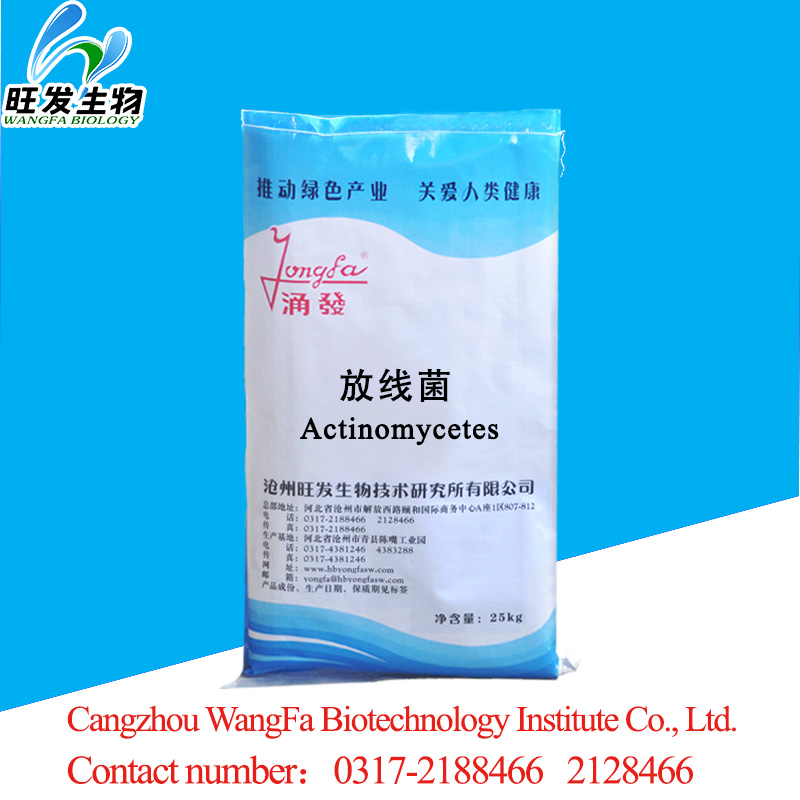
Actinomycetes
This product is a high - tech product by the microbiology experts of the Chinese Academy of Agricultural Sciences and the experts of our company for years of practical experience. It is a highly efficient biological fermentor used to produce high quality bio organic fertilizer and agricultural cultivation. Because of its special fermentation, its activity is strong and its metabolites are abundant, so its dosage is small and its effect is obvious.
Actinomycetes and fermentation metabolites
[character] powder
[biological characteristics] actinomycetes are a group of prokaryotes. Most of the developed branching mycelium. The mycelia are slender and the width is nearly rod-shaped bacteria, about 0.5-1 mu m. Actinomycetes are named because of their colonies. It is a group of prokaryotes, widely distributed in nature, mainly spore propagation, followed by disrupted reproduction. Gram staining was positive.
Actinomycetes are widely distributed in nature, mainly in soil, air and water in the condition of spores or mycelium, especially in soil with low water content, rich organic matter, neutral or micro alkaline soil.
Most actinomycetes are aerobic, and only some strains are microaerobic and anaerobic. Therefore, adequate ventilation should be guaranteed during the process of industrial fermentation to produce antibiotics, and the temperature has an effect on the growth of actinomycetes. The optimum growth temperature of most actinomycetes is 23-37 C, the growth temperature range of actinomycetes at high temperature is 50-65 degrees C, and many strains still grow well at 20-23 degrees centigrade; actinomycetes mycelium body ratio The bacterial vegetative body has strong anti drying ability. Many strains can survive in a calcium chloride and sulfuric acid dryer for about a year and a half.
The main function of actinomycetes is to absorb nutrients. In addition to a few autotrophic strains, such as Streptomyces autotrophic, most of them are heterotrophic. Heterotrophic bacteria differ greatly in their nutritional requirements. Some can use simple compounds, while others require complex organic compounds. They can use different carbohydrates, including sugar, starch, organic acids, cellulose and hemicellulose as energy sources. The best carbon source is glucose. In terms of nitrogen nutrition, protein and some amino acids were most suitable, followed by nitrate and ammonium salts.
[main functions] 1. Actinomycetes are closely related to human production and life, and about 70% of the widely used antibiotics are produced by various actinomycetes. Some kinds of actinomycetes can also produce various enzyme preparations (protease, amylase and cellulase), vitamin B12 and organic acids. 2. Actinomycetes can be used for seed dressing, or applied to root soil, directly acting with pathogenic bacteria to prevent Fusarium wilt caused by Fusarium. Controlling Tomato Early Blight and controlling powdery mildew of cucurbits. 3, to promote plant growth, actinomycetes produce plant hormones and Growth Accelerators through nitrogen fixation, which directly promote plant growth, and increase the dry weight and chlorophyll content of plants and develop the root system. 4. Heavy parasitism, actinomycetes are heavily parasitized in the mycelial body of the pathogenic bacteria, causing the mycelium to be distorted in shape, thus breaking up and preventing the disease.
Note: the living bacteria content can be customized according to the demand.
(scope of use) agricultural cultivation and fertilizer production.
Store in a cool, dry place.
(shelf life) for 18 months.

